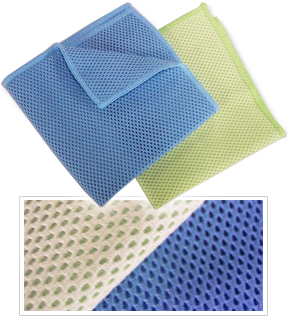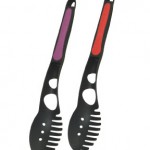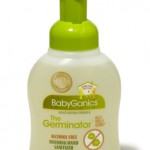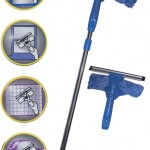Here’s a job that often makes people stop and think. You’ve spent a bunch of money on shiny new non-stick cookware, and it fries a mean egg, but how do you clean it? Should you hand wash, or put them in the dishwasher? If you wash by hand, what tools are safe to use on this expensive surface? It’s safe to say that no pans are really dishwasher safe, so most of us end up washing them by hand. Some manufacturers will claim machine wash safeness, but we all know that this will lead to shorter product life, rusting, peeling finishes and even warping pans. The safest and most effective way to get non stick pots and pans clean is to do it by hand.
That’s all well and good, but plain old hands aren’t too abrasive, so there needs to be a tool involved here somewhere. Most of us have some sort of green scrubby device, a regular sponge, dirty dish rags, steel wool and other various implements that we use to wash dishes, but all of these will be either dangerous or ineffective when it comes to washing those dirty pans. Cookware like this gets used a lot, and ends up super dirty after the cooking is completed, so you will definitely need something abrasive to scrub off caked on food and other crusty dirtiness. But when choosing a tool, you run in to the issue of what is abrasive enough to remove the grime, but gentle enough to leave the non-stick surface unharmed. Although these surfaces are pretty tough, using the wrong tool can cause instant damage, and down right wreck your new pan. If the finish gets removed, or starts to peel then it can make it hard to cook, and can even be dangerous health wise to eat off of.

Ultimate Kitchen Cloths
Choosing the right tool can make this job easy. It can be a quick and painless task in which you remove dirt from your cookware quickly, without trying hard, and without risking any damage to the non-stick surface. The ultimate kitchen cloth is the perfect all around dishrag for scrubbing and cleaning surfaces all throughout your kitchen. It can deep clean surfaces without harming them, and has the unique ability to be pretty darn abrasive without harming delicate surfaces. They look like mesh cloths, but are made from microfiber, so they are designed to clean. The pattern and weave of these cloths will scrape and skim the surface of your pots and pans to easily remove any cooked on food and other dirt from any type of non-stick cookware. It will power right through the toughest stains and debris to leave the surface clean without ever risking damage. You can use these with or without soap to scrub any dish you have. Because they can really scrub and remain gentle at the same time, they are perfect for non-stick cookware, but you can use them all over. Clean cabinets, counters, glasses, your fridge and more with this versatile little cloth. They work on greasy stuff, gooey stuff, crusty stuff and anything else you might encounter.
Instructions for use:
- When washing non-stick pots and pans with super extra tough, cooked on grime, you may want to soak first.
- To soak, simply fill with hot water and add dish soap. Let sit for anywhere from 20 minutes to overnight.
- For regular cleaning, no soaking will be necessary.
- To wash like normal, fill sink with hot water, add soap, and stick in your pan.
- Ensure you cloth is clean and free of debris, saturate with soapy water, and then begin to wash.
- Use a circular motion, or an up and down, back and forth motion. Apply light pressure as you wipe.
- The soap will help to free debris and clean the surface, but the cloth will cut through dry stuff, lift up food particles, and scrub away all of the yucky stuff. This powerful kitchen cloth will give the same ability as one of those harmful scouring pads, but you will not have to worry about scraping up the finish as you wash.
- If one side gets dirty, flip over and keep cleaning.
- After you finish, rinse the pan and set up to dry. Rinse your cloth and hang for later use, or toss in the wash for cleaning. Each one can be used thousands of times, and they will not wear down like scrub pads and sponges do.
 Scrub N Rub Mitt
Scrub N Rub Mitt
The Scrub n Rub Mitt offers similar benefits, and method of use, but it has some added features. A similar weave will do the scrubbing for you, but this one will actually deliver even more scrubbing power due to it being a slightly different, and more abrasive material. It is still totally safe to use, but might be more effective for certain scrubbing jobs. This tool is also double sided, so you can use the other side for more run of the mill cleaning and even to dry dishes after you are done. It has a terry finish microfiber on the back side that can be used wet or dry to clean and dust surfaces. The versatility of this mitt may be ideal for some people, but you give up absorption, storage space, color choice and other things when you choose this mitt over the cloths. Both will do a great job washing your non stick pots and pans, so it will really come down to preference as to which tool is best suited to you. The Scrub n Rub is a mitt instead of a cloth, so some people will have a preference for it just because of that reason.Your hand will remain contained and covered as you clean, so you can protect your skin from dish soap and the dirt you are cleaning.
Instructions For Use:
- Although the powerful scrubbing side can wipe away most food, soaking first may make your job easier. It will remove any loose stuff, and free up any stuck stuff, and that results in a less messy job that you will finish with faster.
- After soaking, or if you do not need to, submerge your pans into soapy water, and grab your mitt.
- You can use it as a pad with your hand on the outside, or you can slip your hand in to prevent it from touching the grime.
- For pot and pans that are not that dirty, use the soft side to clean them thoroughly.
- For cookware that is tough to clean, flip it over and use the scouring side to power through the grime.
- A combination of both side has proven to be quickest and most effective for all types of dish washing.
- A circular scrubbing motion will free stubborn food, and cut through cooked on debris. The plasticy material is perfect for scrubbing this delicate surface because it is highly effective and totally safe at the same time. Easily lift up food that is stuck, and never leave a scratch or peel behind.
- Once finished, rinse your pan and allow to dry. Hang mitt to dry after rinsing for later use. Each mitt can be used over and over again, and laundered hundreds of times.
When you are using the right tool, washing non-stick cookware is not scary at all. You can still scrub and scour without any risk to the finish, just so long as you have a cleaning tool designed for this purpose. There are other similar tools out there, but we recommend these because we have fully tested them for quality, ease of use, and most importantly end results. They deliver a quick and efficient way to get cookware clean without damage, and they make it fast and easy to do so. Switch to one of these tools to make your job easier and lower the risk involved at the same time.





 Ordering Info
Ordering Info Customer Service
Customer Service Follow Us
Follow Us Search For Stuff
Search For Stuff Find Us
Find Us Call Us
Call Us Pay Us
Pay Us

that was very informative. i look forward to more. thank you. good sence.
I would always think of how to clean my non stick pans, but ultimate kitchen cloth has solved all my worries?